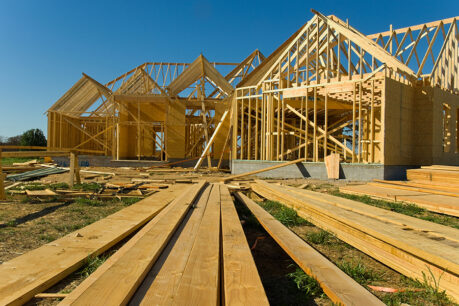
With the housing market and inventory in a constant state of flux, homebuyers are looking for alternative and sustainable solutions for homeownership—such as system-built homes.
Many embark on the journey of owning a system-built home with a mix of excitement and uncertainty, often feeling overwhelmed about where to begin. But rest assured, we’re here to simplify the complexities.
We’ll explore the foundations of system-built homes and the various types of these homes. Then delve into the world of construction loans, to help you gain the confidence and empowerment to turn your dream home into a reality.
What is a system-built home?
A system-built home, or system-built construction, can also be referred to as a prefabricated home. These homes are built off-site rather than on the home’s property, like traditional stick-built homes.
System-built homes are typically built in sections or modules and then are transported to the home’s property for final assembly. These homes offer several advantages, including quality control, efficiency, and cost-effectiveness.
These homes are typically built within factories or a controlled environment that isn’t subjected to the weather or other on-site challenges, like unexpected piping.
Additionally, many system-built homes are constructed quickly because tasks may be done simultaneously.
System-built homes usually come with a wide range of design options and customization including various floor plans, finishes, architectural styles, and energy-efficient features.
Often, system-built homes may be more cost-effective than traditional on-site construction. However, this may vary depending on different factors, such as customization, builder/contractor costs, and transportation.
What kind of homes can be built with system-built construction?
- Modular homes are built in modules, or sections, and transported as such until they are put together on the property’s location.
- Manufactured homes are entirely built within a factory or controlled environment and then transported to your property’s location.
- Panelized homes have structural components, such as the floors, walls, and roof, pre-built within a factory and then constructed on-site.
- Pre-cut homes, also known as kit homes, are homes that also have structural components pre-cut and designed in a factory. However, assembly is required either by the owner or by a contractor.
- Log homes are also considered system-built because the logs are pre-cut off-site and then shipped to the final destination, ready to be built.
The biggest things to compare when choosing a home type are the quality of materials, the construction timeline of each one, and of course, the price and how each one fits into your budget.
Construction loans for system-built homes
Every construction loan comes with its benefits and advantages, but knowing what your homeownership goals are may help narrow down the loan products.
If eligible, you may use federally backed construction loans for a system-built home. The Federal Housing Administration (FHA), Department of Veteran Affairs (VA), and United States Department of Agriculture (USDA) all offer construction loans for qualifying individuals. However, you’ll have to meet specific requirements.
Some typical requirements you may expect with federally backed loans include:
- Down payment requirements
- Loan amount limits
- Property restrictions
- Home inspections
- Loan fees
While these requirements are common, they may also vary depending on which type of loan you choose.
For example, VA loans usually don’t require a down payment; however, you must satisfy the minimum service requirements on when you served as a veteran, an active duty service member, a reservist, a member of the National Guard, or are a surviving spouse of a veteran to be considered eligible.
For larger projects in high-cost areas, you may need to apply for a jumbo construction loan. Jumbo construction loans do not have to follow the maximum loan amount limit for conforming construction loans that the Federal Housing and Financing Administration (FHFA) establishes.
On the other hand, conforming construction loans, which are sponsored by government entities such as Fannie Mae or Freddie Mac, also provide financing for system-built homes.
All this is to say that borrowers have many potential loan options to build a prefabricated home. It’s essential to work with a lender who has experience with providing conforming, nonconforming, and federally backed loans so that you may review all of your options.
Steps to get a construction loan
To start, obtain a pre-approval letter from your lender before you apply for a construction loan. Pre-approvals estimate the loan amount you’re likely to qualify for.
Though not a loan commitment, pre-approval can help you set your budget and provide you with peace of mind that you’ll be able to secure financing.
You’ll also want to have your building plans prepared. Your lender will need to assess your project to determine your loan amount, the costs and risks involved, and to ensure your contractor’s credibility.
Once you have your financial information, personal documentation, pre-approval, building plans, and contractor information, you’re ready to apply for loan approval.
After approval, you must complete the necessary paperwork and make your down payment to close on the loan.
Construction-to-permanent loans are good choices for system-built homes because they roll the cost of construction and your primary home loan into one loan, meaning only one application process and set of closing costs.
Other construction loans may require you to apply for a second home loan as well, in which this new home loan would cover the balance of the construction loan.
If you want to expedite the process and save money on closing costs, then a construction-to-permanent loan may be the right loan for you.
Once construction is finalized, your construction loan will convert into your primary home loan, your monthly payments will begin, and you may move into your newly built home.
Take the next step with The Federal Savings Bank
Borrowers don’t have to get discouraged by housing inventory shortages. System-built homes offer endless possibilities for borrowers. These homes can make your dream of a custom home a possible reality with a construction loan.
The Federal Savings Bank offers construction loans for system and stick-built homes, so no matter which type of home you want to build, we may have the solution for you.
Ready to start your homeownership journey and build your dream home?
Get started with The Federal Savings Bank for experienced guidance and competitive rates.
Subject to credit approval. Terms and conditions may apply. Subject to VA eligibility requirements. Property insurance is required on all loans secured by property.
Down payment assistance requirements are based on the mortgage insurer or guarantor’s guidelines. Borrower may fund down payment and closing costs. Down Payment Assistance Program, which assist eligible homebuyers with purchasing a home. Down payment assistance programs are not eligible for all potential homebuyers.
This article is intended for general informational and educational purposes only and should not be construed as financial or tax advice. For more information on financial planning or investment advice, consult a registered investment advisor or financial planner. For tax advice, please consult a tax professional.
This information is intended for educational purposes only. Products and interest rates subject to change without notice. Loan products are subject to credit approval and include terms and conditions, fees and other costs. Terms and conditions may apply. Property insurance is required on all loans secured by property. VA loan products are subject to VA eligibility requirements. Adjustable Rate Mortgage (ARM) interest rates and monthly payment are subject to adjustment. Upon submission of a full application, a mortgage banker will review and provide you with the terms, conditions, disclosures, and additional details on the interest rates that apply to your individual situation.


